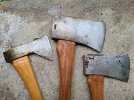- Joined
- Jul 3, 2019
- Messages
- 14,650
FortyTwoBlades can take all the fun out of responding to threads by being so damn right all the time.
The BladeForums.com 2024 Traditional Knife is ready to order! See this thread for details:
https://www.bladeforums.com/threads/bladeforums-2024-traditional-knife.2003187/
Price is $300 ea (shipped within CONUS). If you live outside the US, I will contact you after your order for extra shipping charges.
Order here: https://www.bladeforums.com/help/2024-traditional/ - Order as many as you like, we have plenty.
And it should be at 57-58 or even harder, in my opinion. Their standard is 1060 and that handles 57 no problem. The steel serves little benefit over 1060 in that hardness range. If taken harder it could support a thinner geometry than 1060 without becoming brittle. At 52 it'll be indistinguishable from 1060.Council Velvicut line uses 5160 at 52-56 HRC.
I'll be danged. Bummer. They're not giving those Velvicuts away either, and I got 3. Still like em though.Andy it should be at 57-58 or even harder, in my opinion. Their standard is 1060 and that handles 57 no problem. The steel serves little benefit over 1060 in that hardness range. If taken harder it could support a thinner geometry than 1060 without becoming brittle. At 52 it'll be indistinguishable from 1060.

One of the current straight razor manufactures uses a .60 carbon steel and probably always has.The eye of an axe can't be terribly hard or it will split on impact or even during hanging - I've done it. The bit can be harder up to a point. It's an impact tool and has to balance toughness with edge holding ability. It has to be sharpenable with simple tools as one might have on the farm or at a logging camp.
Since at least the 1700s it's been common to see axe bodies made of softer material with high carbon bits forge weled and later electro-welded to those softer axe bodies.
Some makers even used very high carbon 'razor steel', which back then usually meany at least 100 points of carbon but could range up to 120 or even 140 points of carbon (i.e. - 1.4% carbon). Hurds advertised their 'Razor Axe' as having the finest steel available for an axe bit. Sear Roebuck's Fulton brand also marketed an 'Razor Axe' with a very high carbon steel. I imagine these must have been well tempered back to avoid cracking and chipping but would have retained excellent abrasion resistance.
Council Velvicut line uses 5160 at 52-56 HRC.
None taken!Not really directed at you Bob so please don't take it that way.
Why is there such a big range here, 52-56 RC, really?
No way are they producing axes like that with modern heat treating methods. Do they have a blind guy under the dim light of the forge judging colors?
Disappointing.
- Forged from 5160 grade alloy steel. “Council” is displayed on one side of the head, and the other is proudly marked “USA”.
- Bit and poll is heat treated and quenched approximately 1 in. from the cutting edge, then tempered for maximum edge holding and toughness. Final hardness Rc 52-56.
That is their premium axe with the biggest swing in the industry? And there is quite a difference in four points of RC hardness.Most companies have a hardness range of 2-3 points scattered around their target hardness, so while their range is larger than typical, it's also not by much.
That is their premium axe with the biggest swing in the industry? And there is quite a difference in four points of RC hardness.
Their regular line...
"Council Tool internal standards call for tempered bit hardness of Rc 48-55 and we target 1-1/4 inches from the cutting edge."
Did GB soften their axes. This is what they used to say.
"The hardness of the bit is measured, 57 Rockwell C, and every single head is tested by a smith who, with a big hammer, strikes on the edge’s corners. If the blade does not break the head is good."
Helkjo--The blade edges are hardened to approximately 53-56 HRC
Wetterlings listed their axe at 57 RwC.
I don't know about HB and the only axes of theirs I own are vintage.
Not confused at all. I was just saying....I'm not sure what your point of confusion is. The info you posted confirms my statement. I agree there's a big difference in 4 points of hardness. When I said "not by much" it's reference to how much larger their spread is compared to others in the industry, that being a 4 point spread as opposed to the more typical 3 point spread. The stated hardness for Wetterlings is target hardness, not the hardness range.
Regarding the 7 point spread of hardness for the standard line, that's not saying that's what the actual tested hardness range is, just what they consider as "within standards". As in if it is considered as faulty or not.
There are many types of carbon steel used in the manufacturing of Straight Razors. Here are a few:
- O1
- 1055
- 1060
- 1070
- 1080
- 1095
- 5160

 www.badgerandblade.com
www.badgerandblade.com
Ah. You phrased it as a question, and that threw me off.Not confused at all. I was just saying....
And then we realized it wasn't at all necessary. From what I can tell the C135 is mostly marketing playing off the false notion that more carbon is inherently harder/better. I suspect, in fact, that if there was any advantage to be had in the use of extra high carbon content it was probably because of inserted bit construction requiring raising the steel to welding heat, and the extra carbon ensuring it didn't lose too much through burning off. But otherwise plain medium carbon steels are able to achieve hardness that's actually excessive for the tool. Steels with more than 0.8% carbon at the time of heat treatment are more finicky to heat treat correctly so for most tools 1080 or less is better to minimize failure rate.But that wasn't always the case. 100+ years ago razors were made with very high carbon steels with 100 or more points of carbon. At least one maker was still making razors recently with 135 points of carbon.

Theirs Issard C135 steel v. Historical forgings steel
After my 6/8 DIW TI in C135 steel has arrived it fairly quickly convinced me to get another Theirs Issard razor (untreatable stage of RAD). Does anyone have any experience with TI Historic straight razors such as: http://www.rasurpur.de/english/shop/shop.html? How do they perform in compressing...www.badgerandblade.com
